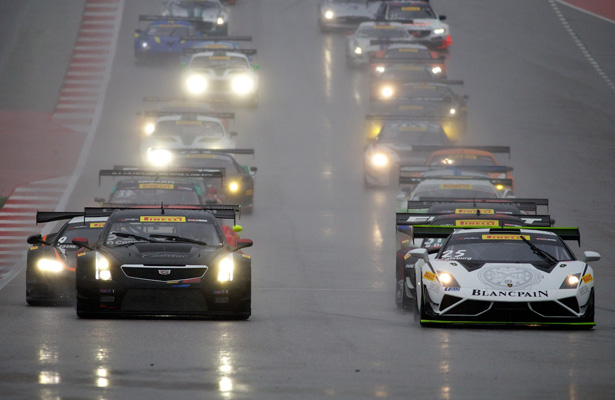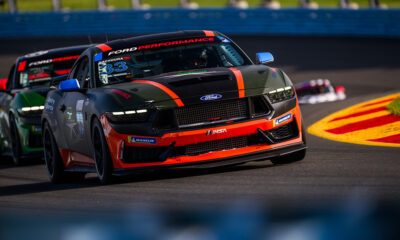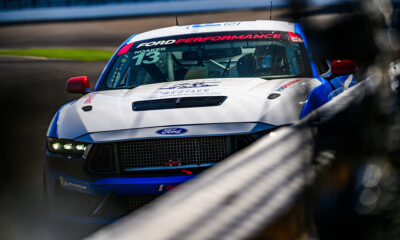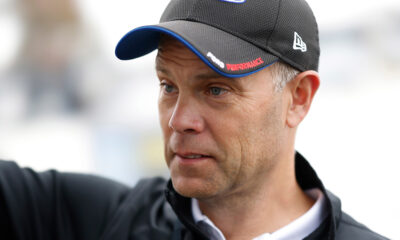
Photo: John Dagys
With a record grid, including one of the most diverse fields of GT3 machinery in the world, expectations were high heading into last weekend’s Pirelli World Challenge season-opener at Circuit of The Americas.
The 26th season of PWC kicked off with entertaining on-track battles, solid officiating and cleaner-than-expected races, although a number of other key items came to light during the highly anticipated event at the home of the Formula One U.S. Grand Prix.
In fact, the paddock had a distinctly different look and feel to it than six months ago at Miller Motorsports Park, site of the 2014 finale, which was showered with optimism amid a somewhat turbulent first season for the TUDOR United SportsCar Championship.
The obvious change in PWC has come with the influx of teams, manufacturers and world-class drivers to the field.
COTA saw the worldwide debut of Cadillac’s new ATS-V.R GT3 racer, and the first U.S. race appearance of the new McLaren 650S GT3, which claimed its maiden win in Sunday’s rain-soaked race with Kevin Estre.
The Frenchman was just one of the nearly half-dozen GT stars to make their series debuts. James Davison and Nick Catsburg were among the debutantes, and Race 1 winner Olivier Beretta made his PWC return after a one-off appearance in 2004.
A number of IMSA teams had also made the off-season switch, or expansion to PWC, with Flying Lizard Motorsports joining forces with K-PAX Racing, Scuderia Corsa, Risi Competizione, TRG-AMR, NGT Motorsport and Turner Motorsport all on the grid for the Texas round.
While the stunning grid in GT/GTA/GT Cup, representing more than $20 million in exotic machinery, delivered two intense and hard-fought races, it’s perhaps PWC’s rapid growth that caught out the series the most on its opening weekend.
A number of complications developed, including, but not limited to, the potential of certain drivers being reclassified from GTA to GT, persistent timing and scoring issues and delays in results and final grids, which led to some confusion in the paddock.
Additionally, the series could arguably add more personnel to account for the increase in customers, and potential media interest, especially with the launch of a new class and going from four to six races over the weekend.
In terms of the races themselves, the late decision to move up Sunday’s Race 2 by 30 minutes due to imminent weather caught a number of teams off-guard, as well as its primary audience watching online.
Those who tuned in saw sub-par webcasts compared to recent years, attributed to the simultaneous production of the new-for-2015 CBS Sports broadcasts. To the series’ credit, it avoided a similar dropout of the live stream as occurred in last year’s season opener at St. Petersburg.
The circuit’s reported 30,000 weekend trackside attendance, meanwhile, appeared to be widely optimistic, especially considering no more than 3,000 tickets were reportedly pre-sold. The cold and rainy weather on Sunday certainly didn’t help matters and to its defense, COTA has always been a tough sell for any event other than F1.
Still, local promotion of the event appeared to be non-existent, and even IMSA’s Vice President of Marketing, David Pettit, who visited the paddock on Saturday, said he only stumbled upon the race after stopping by a barbecue restaurant adjacent to the circuit.
There were some silver linings, though, including new hires Marcus Haselgrove and Brian Till, who both stepped up to the challenge, particularly with a new committee-based Race Control that appeared to run without any major controversy.
However, two post-race penalties, including one that affected the GTA podium in Race 1, took nearly 24 hours to confirm, which shows some room for improvement with race administration.
For the fans that turned out, they enjoyed great access, including a pre-race fan walk in the paddock. The fan walk made up for the frequency of some cars hidden behind closed doors in garages.
Although, with a grid that’s only second to the Blancpain Endurance Series, it remains a mystery as to why no effort was made to showcase the impressive array of machinery in a group photo, for example.
There are also some unknowns, with the true results of what we saw at COTA still yet to play out, such as the new CBS Sports TV broadcast. If it’s an improvement over the NBC Sports Network broadcasts, which were often on two-week delays, then it could be one of the positive takeaways from the weekend.
PWC’s first standalone season opener in more than 15 years has brought significant change to the sprint race championship, as well as an opportunity to take the next leap forward in its rapid and, up until now, successful growth plan.
But in order to take two steps forward, you sometimes have to take one step back. And I hope PWC isn’t afraid to react to some shortfalls in order to not just maintain what they have now, but to build it into something even greater.
The views and opinions expressed on this web site are solely those of the original authors and other contributors. These views and opinions do not necessarily represent those of Sportscar365.com, John Dagys Media, LLC and/or any/all contributors to this site.

























